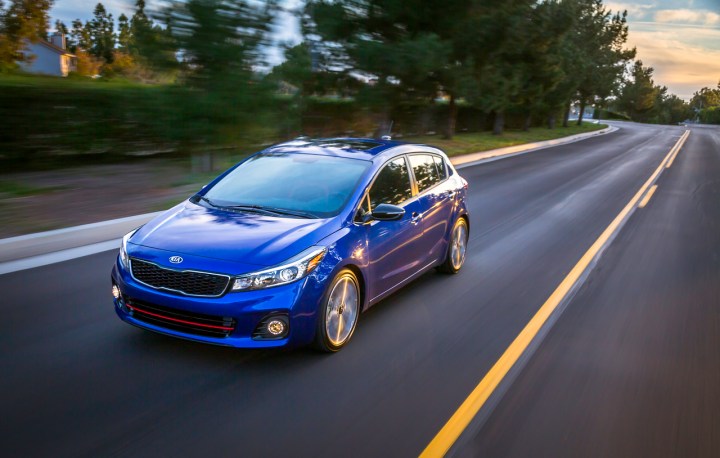
I’ll take the hatch, please
Both members of the duo received visual changes for the 2017 model year, but it was the hatch that underwent the most dramatic cosmetic transformation. Keeping in line with the brand’s new design language, the Forte5 now wears a wider version of Kia’s trademark “tiger-nose” grill, as well as a retouched front bumper and a sweeping headlight design that seems to elongate the car’s profile.
Also new for the Forte5 is a seven-speed dual-clutch transmission, which bolts up to the range-topping 1.6-liter turbo engine. Power ratings and fuel economy numbers are still forthcoming, but the 178-horsepower 1.6-liter turbo found in the 2016 Optima gives us a good ballpark figure. A naturally aspirated 2.0-liter four-cylinder is the standard offering, packaged with either a six-speed manual or six-speed automatic.
Outside of the new look, the biggest changes to the 2017 Forte5 come in the form of tech. Both Android Auto and Apple CarPlay will be available through the UVO infotainment system’s 7-inch touchscreen, with the Android system coming first and CarPlay coming online later. The hatch also offers a new suite of driver assistance features, including Rear Cross Traffic Alert and Blind Spot Detection with Lane Change Assist.
The ol’ standard

If you prefer a traditional four-door silhouette, the Forte sedan has you covered. Like its hatchback cousin, the Forte gains Apple CarPlay, Android Auto, and a variety of driver assist features, but it adds Dynamic Bending Light technology, Autonomous Emergency Braking, Front Collision Warning, Lane Change Warning, and Lane Keep Assist as well.
In terms of performance, last year’s 1.8-liter Atkinson four-cylinder has been axed in favor of a larger 2.0-liter unit, and like the Forte5, it bolts up to either a six-speed manual or a six-speed auto. EX trims get a more powerful 2.0-liter engine, but its output has not been released at this time. Expect the full breakdown, including pricing and other information, to become finalized closer to the on-sale date later this year.


